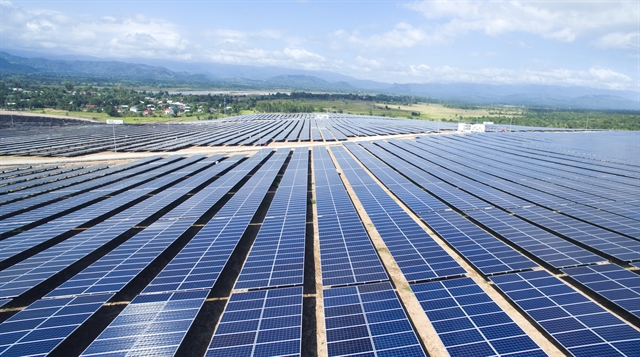 Economy
Economy


|
| A solar power plant in Gia Lai Province. Foreign enterprises and investment funds have a growing interest in the solar energy sector in Việt Nam. — VNS Photo |
HCM CITY — This month saw the inauguration of the largest solar power plant in Southeast Asia, Dầu Tiếng in Tây Ninh Province, by Dầu Tiếng Energy JSC and Thailand’s B.Grimm Power Public Company limited.
It was built at a cost of over VNĐ9.1 trillion (US$384 million).
Japan’s Fujiwara company had earlier built a 50MWp solar farm in Bình Định Province at a cost of VNĐ1.3 trillion ($55.9 million).
Many Indian companies have invested in the Vietnamese solar energy sector, including Shapoorji Pallonji Infrastructure Capital Company Ltd. and Adani Group, and many others have evinced interest in green energy projects in this country.
Dr. K. Srikar Reddy, the consul general of India in HCM City, said: “Many Indian companies have submitted proposals for developing solar plants in many provinces in Việt Nam like Ninh Thuận, Bình Thuận, Bình Phước, Phú Yên, Bến Tre, Sóc Trăng, Gia Lai, Lâm Đồng, and Kon Tum.
“Moreover, many Indian companies specialising in EPC (engineering, procurement & construction) work are looking for opportunities to execute renewable energy projects in Việt Nam.”
In addition to foreign companies, foreign investment funds also have a growing interest in the sector.
After putting into operation the BCG - CME Long An 1 solar plant in Long An Province last June, Vietnam-Oman Investment Fund and BCG-CME Joint Venture plan to begin operating the BCG - CME Long An 2 solar plant next month, Nguyễn Xuân Giao, investment director at VOI, said.
VOI was one of the first foreign investors along with the BCG - CME joint venture to generate renewable energy, he said.
Talking about future investment plans in the sector, Giao said: “VOI is committed to investing large sums long-term in building and developing a chain of BCG - CME Long An solar power plants.”
Nguyễn Hồng Giang, marketing director of Tona Syntegra Solar, a joint venture between a German and a Vietnamese company that specialises in consultancy for solar equipment procurement and installation and connects local and foreign investors, said: “I see a great investment trend among foreign investors in solar energy in Việt Nam. We have worked with many foreign funds, including from Australia, Malaysia and Germany, and they target investments of hundreds of millions of dollars in solar energy.”
Considering that Việt Nam has high demand for electricity to drive economic growth, and the Government offers incentives to encourage investors in the sector, including high feed-in tariffs, it is understandable that foreign investors are eager to invest in the country’s power sector, particularly renewables, according to experts and businesses.
Ingmar Stelter, project director at GIZ Energy Support Programme, said around 4,500MW of mainly large solar power plants went on stream in the three months between April and June 30, when feed-in tariffs were reduced.
“In Germany, we installed half of that in six months. That is the massive dynamic we have seen in the solar market in Việt Nam.”
Giang said investors were waiting for the new feed-in tariffs for solar projects, and if they are as high as they expect, there would be a new boom in the solar energy sector.
Challenges
Despite the great potential, investment in the solar energy sector still faces challenges related to capital, land, electricity purchase price policies, and grid connection.
Giao said: “According to experts’ calculations, to generate 1MW of solar power requires 1- 1.5ha of land (2ha for 1MW of wind power). The central and southern provinces which have potential for solar power are limited in land availability.
“For infrastructure projects, solar in particular, the bank loan interest is still too high. Very few banks have special lending programmes for renewable energy projects.
“It takes three years to build a 500kV transmission line and two years for a 220kV transmission line. A solar power project with a capacity of 50-100MW just takes six to eight months to build.
“Therefore, the development of grid and transmission infrastructure cannot keep up with the progress of solar power projects.”
Stelter said the high concentration of renewable energy projects in Ninh Thuận and Bình Thuận caused grid congestion there, and solar and wind plants had to reduce their power output.
“Indian investors are worried that they have to now operate below capacity due to insufficient transmission infrastructure,” Reddy said.
“To augment the transmission system for evacuation of large-scale renewable energy, Việt Nam could consider developing high-voltage transmission lines similar to the ‘green energy corridor’ in India.”
To develop solar energy, Giao said the Government should develop “a consistent feed-in tariff policy for the medium term (10-15 years), which would reassure investors.”
“The private sector has great potential in solar energy development. Therefore, the Government needs to have mechanisms to encourage banks, foreign funds and international and domestic organisations to participate in the Vietnamese solar energy market.”
The economy is expected to grow at 6.5-7.5 per cent annually until 2030, and requires 90,000MW and 130,000MW of power by 2025 and 2030.
The Government plans to increase solar power from virtually nothing at the end of 2017 to 850MW by 2020, accounting for 1.6 per cent of power output, and 12,000MW by 2030 or 3.3 per cent. — VNS




